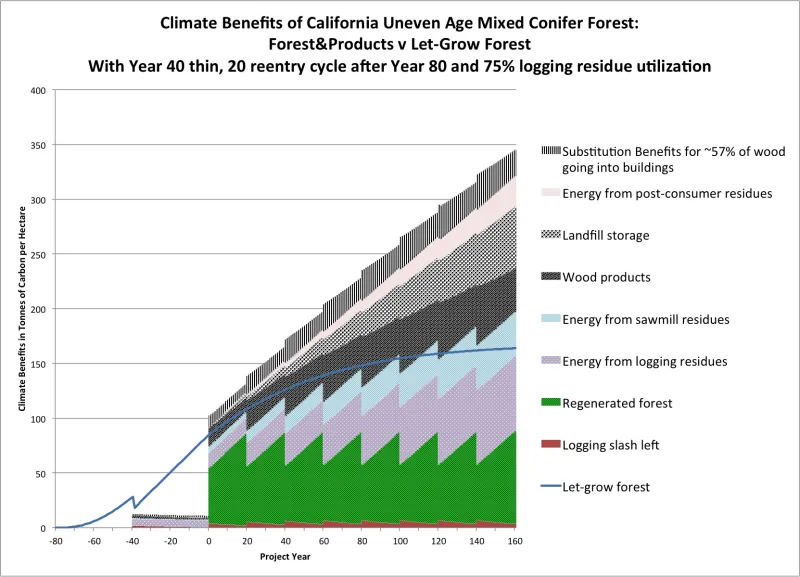
Carbon sequestration was included as one of the values that must be considered and reported on when a timber harvest plan (THP) is submitted for timberlands managed with the “goal of maximum sustained production of high-quality timber products” under the 2010 amendments (AB 1504:carbon sequestration) to the Forest Practice Act. Calfire’s Greenhouse Emissions Calculator (Anonymous 2010) is one way to provide an estimate of carbon sequestration. One problem in Calfire’s calculator is that is assumes that only 38% of board feet measured in their model of a forest are actually turned into board feet of lumber. Scribner board foot measurements in the forest were designed to be an accurate estimate of historic sawmill board foot output (Dilworth 1977) so 100% of the board feet measured in the forest should come out as lumber. Changes in the size of logs and improvements in sawmill efficiency result in an overrun where more board feet are produced from the sawmill than are measured in the timber inventories (Keegan, Morgan et al. 2010). Recent sawmill surveys in California (Morgan et al. 2012) measured wood utilization rates of 99% when wood used for energy is also included. A recent analysis ( Stewart_Nakamura_FPJ2012_Full_GHG_Accounting ) using the national GHG inventory standards for harvested products from 17,000 acres in California documents climate benefits from sustainably harvested products that are four times as large as those considered under current California accounting rules. Canadian Forest Service researchers ( smyth_2014_canadian_forestC ) recently published a comprehensive forest and forest products assessment that illustrates the national level potential for climate change mitigation of forests.
To provide a more accurate tool to estimate the carbon sequestration of sustainable forestry that involves planned harvesting and forest regeneration we developed a manual ( How to use the Berkeley Forest Carbon Calculator for a timber harvest plan ) that provides guidance on how to use models calibrated to California's major forest types:
- Mixed Conifer New mixed conifer calculator with fuels tmts
- Ponderosa pine Berkeley Forests - Ponderosa pine Carbon Calculator for THPs
- Douglas-fir Berkeley Forests - Douglas-fir Carbon Calculator for THPs
- Redwood Berkeley Forests - Redwood Carbon Calculator for THPs
These provide well documented estimates of total carbon sequestration benefits for a number of forest management approaches. The manual and spreadsheet model are based on well documented publicly available data for the major forest types in California. Users can use the default 'best practices' coefficients for different management.
The take home message is that a well-managed forest will create even more carbon sequestration than a let-grow forest when the wood products are efficiently used. Efficient use of wood products is the 'best management practice' in most, but not all, cases in California.
The article "Carbon calculator tracks the climate benefits of managed private forests" by William C. Stewart and Benktesh D. Sharma published in California Agriculture January/February 2015 CarbonCalculator_Stewart_Sharma_CalAg_2015 provides an overview for the major forest types in California.
A step by step memo ( how to use apr 2015 version ) on how to use the calculators was updated in April 2015. For forest treatments that are not THPs with a significant stream of commercially valuable products that also generate climate benefits, there is the need for an approach to estimate the climate benefits of projects such as fuels reduction treatments and forest health treatments that are projected to provide net climate benefits by reducing future disturbance losses. While there are many expensive and complicated models designed to produce estimates, few have been validated against empirical data.
Fuels treatments
As California forests begin to experience significant drought mortality in 2015 that may be the precursors to even greater losses associated with wildfires and insect outbreaks, there is strong interest in providing a simple approach to estimate net climate benefits under a clear and transparent set of assumptions. A beta version of a fuels treatment scenario spreadsheet model ( Sept15_fuelstmt_sheet_beta ) provides a range of estimates of the climate benefits of different fuels treatments. The memo ( Estimating the carbon-climate benefits of fuels treatments Sept 15 ) describes the method. The assessment illustrates the importance of using reasonable estimates for future wildfire severity and return interval as these assumptions have large impacts on the eventual estimate of the net climate benefits of the treatments.
Presentations
Bill Stewart's presentation for the September 5, 2014 public workshop on AB 1504 can be accessed here WCS AB 1504 sept 5 2014 presentation .
Bill Stewart's presentation for the April 13, 2015 webinar describing a forest carbon calculator for California. Presentation Recording
Bill Stewart's presentation ( Stewart NWL forestry as Climate Pillars ) on increasing forest and forest products carbon benefits in California for the Natural and Working Lands as a Climate Pillar symposium of August 5, 2015.
References
Anonymous. (2010). "Greenhouse Emissions Calculator Users Guide, California Department of Forestry and Fire Protection." Retrieved August 23, 2012, from http://www.fire.ca.gov/resource_mgt/downloads/THP_GreenhouseGasEmissions_Calculator_UserGuide_061110.pdf. download spreadsheet under 'Climate Change' at http://calfire.ca.gov/resource_mgt/resource_mgt_forestpractice_pubsmemos_memos.php
Dilworth, J. R. (1977). Log Scaling and Timber Cruising, Oregon State University Press.
Keegan, C. E., T. A. Morgan, K. A. Blatner and J. M. Daniels (2010). "Trends in Lumber Processing in the Western United States. Part II: Overrun and Lumber Recovery Factors." Forest Products Journal 60(2): 140-143.
Morgan, T. A., J. P. Brandt, K. E. Songster, C. E. Keegan, III and G. A. Christensen (2012). California’s forest products industry and timber harvest, 2006. . Portland, OR, U.S. Department of Agriculture, Forest Service, Pacific Northwest Research Station. PNW-GTR-866: 48.
Skog, K. E. (2008 ). "Sequestration of carbon in harvested wood products for the United States." Forest Products Journal 58(6): 56-72.
Smyth C. E., Stinson G., Neilson E., Lemprière T. C., Hafer M., Rampley G. J., and W.A. Kurz. 2014. Quantifying the biophysical climate change mitigation potential of Canada's forest sector. Biogeosciences 11: 3515-3529.
Stewart, W. C. and B. Sharma (2015). "Carbon calculator tracks the climate benefits of managed private forests." California Agriculture. January-March: 21-26
